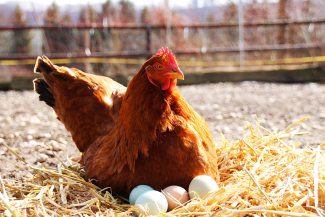
Since May 2021, it has been possible to vaccinate long-cycle poultry against Salmonella during the production period. This benefit is due to the variation obtained for the Primun Salmonella E product, a vaccine produced by CALIER . The European agencies have considered that the extension of immunity generated by application in laying and the non-excretion of vaccine salmonellae in faeces and eggs make this vaccine effective and broadly safe for this use.
Salmonella in poultry - due to certain serotypes such as Salmonella Enteritidis and Salmonella Thiphymurium, among others - is a zoonotic disease that must be monitored in flocks of breeders, layers and broilers.
In Europe, there are specific control programmes aimed at controlling the presence of these Salmonellae and at reducing their prevalence to below 2% in layer flocks (National Programme for the Control of Salmonellae in Spain in Layers, General Directorate of Health of Agricultural Production).
In addition to the recommended biosecurity protocols and the implementation of self-monitoring for the presence of Salmonella in poultry, the national control programmes include vaccination as a compulsory control method, particularly for farms engaging in the intra-Community trade of eggs for human consumption.
Until now, the use of live vaccines against salmonellosis in poultry was strictly limited to the rearing phase of the poultry (layers or breeders) and could not be used in the laying phase. The reasons given were the possible excretion of a vaccine strain that could interfere with control programmes and the absence of data that could demonstrate an increase in protection beyond that which is provided by the vaccines applied in the rearing period.
The current situation indicates that laying hens' production cycles extend beyond 100 weeks, with good laying rates and therefore with good returns for poultry farmers. However, the immunity against salmonellosis provided by a 3-dose posology in the rearing period can hardly cover an entire production period.
The analysis of the technical specifications of the different vaccines on the market reflects a duration of immunity of between 60 and 80 weeks maximum. This means that in a 100-week cycle there would be a theoretical protection gap of at least 20 weeks.
It seems logical to think that the only option is to vaccinate during the laying period to amplify the protection generated in the rearing period and cover the weeks of risk against any Salmonella infection.
Calier considered that it would be appropriate to gauge the opinion of specialists in this field as to what the requirements should be from the protection, safety and application standpoint so that a vaccine could be used in the laying period.

Video: what characteristics a vaccine for use in laying should have
In summary, the requirements for a Salmonella vaccine in poultry for use in laying should be as follows:
- Extended protection throughout the productive period
- No excretion of the vaccine strain in eggs or faeces
- Easy application: drinking water as the preferred route
Primun Salmonella E has been marketed in Europe for more than 5 years, and authorisations have also recently been obtained in countries such as Colombia, Argentina and the Dominican Republic.
Since May 2021, Primun Salmonella E has obtained a variation from the Medicines Agencies authorising its use in the laying period in the European countries where it is registered.
This authorisation was obtained thanks to the studies provided by CALIER that demonstrate the absence of excretion in both faeces and eggs (shell and inner content) as well as a significant extension of protection.
Thanks to these studies, the SPC (Summary of Product Characteristics) of Primun Salmonella E contains the indications and requirements for this use:
- Dosage extended to the production period:
Chicken (future layers and future breeders): a single dose from one day of age, followed by a second vaccination at the age of 6-8 weeks and a third vaccination at 15-20 weeks at least 3 weeks before the start of laying. A fourth vaccination can be used during the laying period at 55 weeks to reduce caecal colonisation and excretion of field strains.
- Poultry in the laying period:
Can be used during laying
- Withdrawal period:
Eggs: 0 days after the fourth vaccination in laying
- Easy application:
Administration in drinking water
With this new indication, the prescribing veterinarian can use Primun Salmonella E during the laying period, thus increasing protection and being able to rely upon the product's safety in terms of vaccine strain excretion.
Primun Salmonella E is a freeze-dried live vaccine and as such is easy to apply (drinking water). In addition, as a live vaccine it activates the 3 possible immunity mechanisms: cell protection, humoral protection and competitive exclusion.
Primun Salmonella E thus becomes the first live vaccine against Salmonella in poultry for an authorised use in the laying period. CALIER demonstrates once again its focus on layers and its commitment to sustainability.